Spying a woodpecker is sort of a “sweet spot” in birdwatching. While they don’t wear the flashy colors of songbirds like warblers and vireos, they are graceful and beautiful to observe in their own right. Though most are relatively common, their ways seem to set them apart. They seem somehow more a part of the wild world than the robins, blackbirds or other common birds that live in our backyards.
Woodpeckers have an “otherness” about them, with qualities that are unique among the bird families. Passerines, including all songbirds, have three forward-facing toes and one backward-facing toe, an adaptation designed for perching. While woodpeckers can also perch, they have “zygodactyl” feet: Two claws point forward and two point back. This gives them the ability to grab hold of a tree trunk and crawl vertically up or down.
Furthermore, while woodpeckers have calls that range in delivery from the squeaky to the rowdy, they don’t sing. They let the songbirds do the singing while they drum, and everybody knows that drummers are wired a little differently than the other members of the band.
Woodpeckers have some amazing adaptations to support their foraging and nesting habits. Cells on the end of their chisel-like beaks are constantly regenerating to stay sharp. They have translucent third eyelids and bristle-like feathers over their noses, both designed to protect them against inhaling sawdust as they work. Plus, they have extra-strong neck muscles and a tightly packed and shock-absorbed brain, so contrary to myth, they don’t suffer from headaches.
Worldwide, the Family Picidae is made up of 263 species, ranging in size from the 3-4 inch long Rufous Piculet of South Asia to the two-foot long Imperial Woodpecker, a now-extinct bird of Mexico. There are 23 species in North America. Most are dichromatic: Males are distinguished from females by flashes of red on their head or throat and sometimes by a dark “moustache” called a malar stripe. All woodpeckers make their homes in cavities excavated from usually dead or dying trees, and they all feed on insects, seeds, nuts and berries, though a few have more specialized diets.
The woodpeckers that you can encounter in Florida range in appearance and personality from the tame little Downy to the imposingly large Pileated. You’ll learn about each of them, plus you’ll learn about an extinct woodpecker that once roamed the forests and swamps.
Let’s meet the woodpeckers who breed in or migrate to the Sunshine State and find out what makes each of them special.
8 Species of Woodpeckers in Florida
Here are the 8 woodpeckers you can find in most parts of Florida. For each bird, we’ve added a “birding hotspot”, a place where you could potentially make new woodpecker friends while hiking and exploring in one of the state’s protected natural areas.
Red-bellied Woodpecker (Melanerpes carolinus)

The Red-bellied is Florida’s most common woodpecker. With its loud drumming and its ear-piercing “Churrr!” call, it will always let you know when in its in town. Its so-called red belly is really white with only the slightest tinge of red. Males and females both have back and wing feathers that are black with wavy bars of white, and both sexes have flashes of white on their wingtips. The distinguishing difference is in a flash of red feathers which the female only has on the back of her head and over her beak and the male wears like a helmet.
Like all woodpeckers, the red-bellied can be identified by its undulating, up and down flight pattern, with protruding finger-like tips on its wing feathers. This is a technique developed to expend less energy in flight. The Red-bellied will circle slowly around its tree to warn off rivals and predators. While it has one of the noisier drum sounds, rattling off 19 beats in a second, that sound is strictly for show, as the bird feeds primarily by delicately picking insects out of bark with a barbed tongue, which it can coat with sticky salvia and protrude out to two times the length of its beak.
Red-bellied Woodpeckers will also visit backyard bird feeders for suet, nuts or sunflower seeds. Unlike songbirds, they can use those zygodactyl claws to grab hold of the bottom of a feeder, then use that long tongue to stash the nuts and seeds they gather into the crevices of bark. Their range of habitat, from riverbanks and swamps to deciduous woods, farm fields and urban parks, together with their omnivorous diet, have kept their population stable and made them among the more successful of common birds.
The Golden-fronted Woodpecker, a related bird that lives mostly in Mexico and Central America, has been documented as a vagrant species in Florida. According to Audubon, a male Golden-fronted Woodpecker documented in the state mated with a local Red-bellied Woodpecker and stuck around long enough to raise a family.
- Size: 9.4” long / wingspan – 13.0 – 16.5”
- Florida Status: Most common species in the state year-round
- Birding Hotspot: Green Cay Nature Center and Wetlands, Palm Beach County
Northern Flicker (Colaptes auratus)
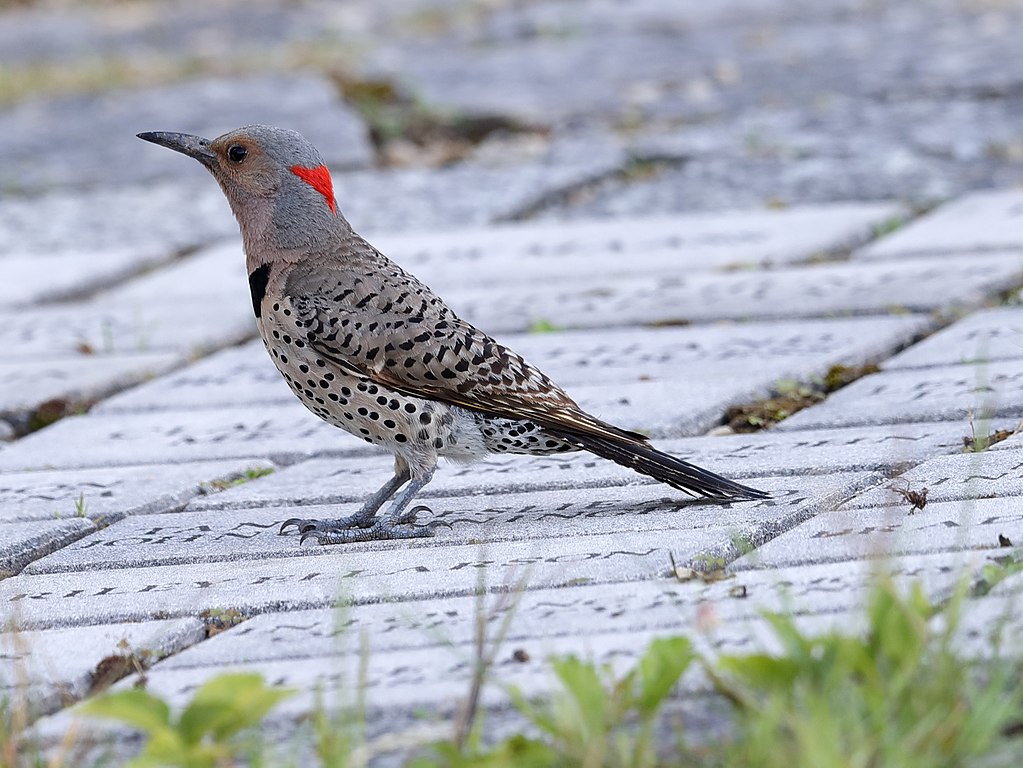
With their similar body shapes, it’s easy at first glance to mistake a Northern Flicker for a Red-bellied Woodpecker, but there are obvious differences in plumage between the two birds. The Flicker has a brown back and wings, both streaked with black, plus a solid black band below its throat and a spotted breast. Both the male and female flicker have a gray crown on an otherwise white head, and both sexes sport a bright red patch on the back of the head. The male is distinguished only by his moustache.
A flicker can also be identified by what it’s doing and by its call. Unlike other woodpeckers, it does some of its foraging on the ground, often in large flocks like robins. It has special tongue adaptations and a slightly curved bill for gathering up ants and beetles. Flickers are also known to catch insects in mid-air and to prey on bats as they leave their roosts. Their call is a long, loud “Kikikiki!” that broadcasts across the open fields of its habitat. The bird gets its name from the manner in which it flicks it’s wings and displays its tail when courting or defending its territory.
Two geographical variations of Northern Flickers live in the U.S., the red-shafted and the yellow-shafted. The different colors appear in the tails and can be observed on the undersides of their wings and tail feathers in flight. Florida’s flickers are of the yellow-shafted variety, while the red-shafted flickers are common in the western states, although their territories overlap in parts of the Midwest. Although Flickers migrate locally in search of food, more so than most other woodpeckers, they can be found at any time of year in Florida.
- Size: 11.0 – 12.2” long / wingspan – 1.5 – 20”
- Florida Status: Widespread and abundant statewide in all seasons
- Birding Hotspot: St. Mark’s National Wildlife Refuge, Wakulia County
Downy Woodpecker (Picoides pubescens)
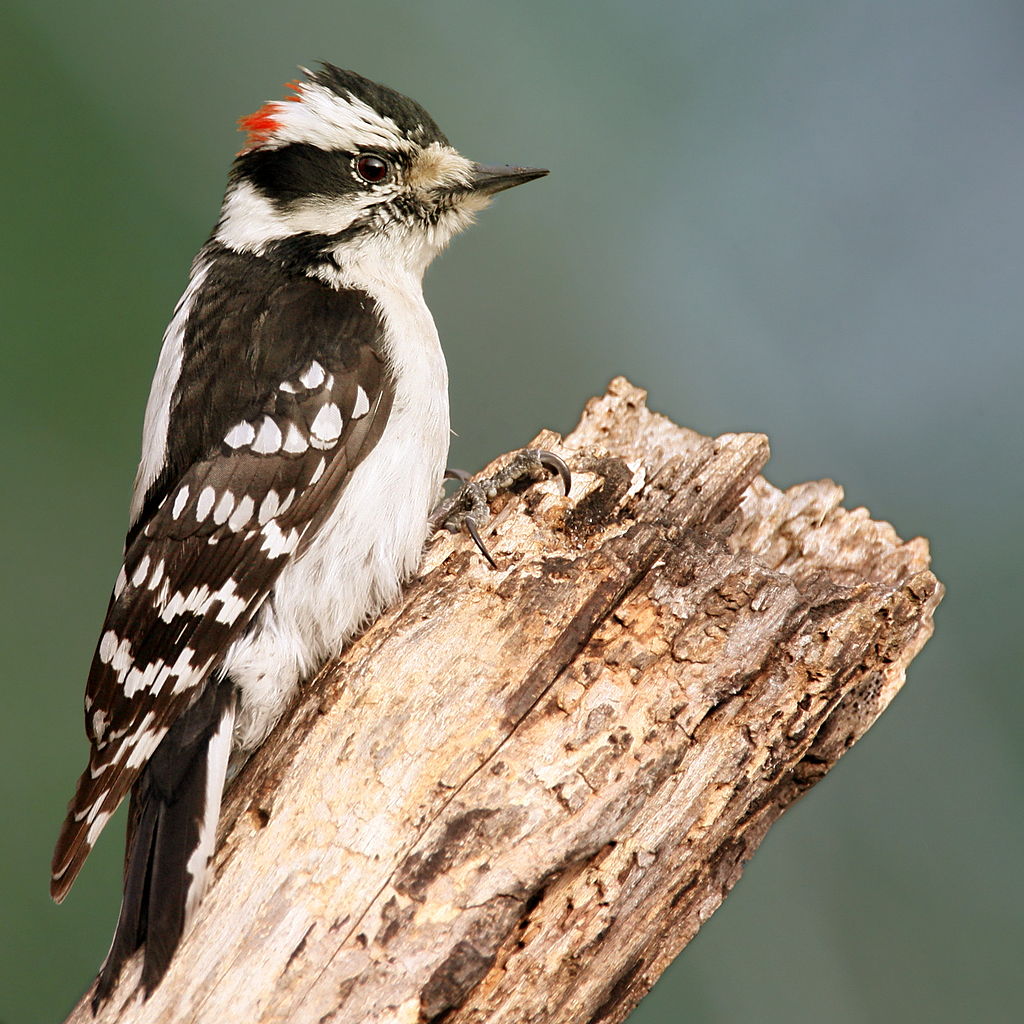
The smallest of Florida’s resident woodpeckers, Downy Woodpeckers are good at making friends. They are among a group of species, also including chickadees, titmice and white-breasted nuthatches, that forms mixed flocks in winter. The advantage to sticking together is that there are more eyes to watch out for predators while foraging.
The chickadees in the group, with their alert nature and knack for finding food, usually serve as the flock leaders. While the Downy Woodpecker might be hopping up a tree with its back to a watching hawk, the chickadee is perched at the top of that tree with a 360-degree views, and it will be the first to warn the others of potential danger. These birds all tend to be relatively comfortable around humans, and mixed winter flocks have been trained to feed out of peoples’ hands.
The Downy Woodpecker has the same body shape as larger woodpeckers, but everything is scaled down to a bird about the size of a house sparrow. Both the male and the female have a pale white breast, black wings with white stripes and a patch of white on an otherwise black back. Like many woodpeckers, the male is distinguished by a patch of red on a black and white head. Their drumming is usually not loud enough to hear, but they can be identified by their high-pitched “Pip-Pip-Pip!” call.
Like most woodpeckers, the male and female take turns incubating a nest of up to six eggs, which can hatch in 12 days. Young birds leave the nest in as little as three weeks, but they stay close to mom and dad for the first few weeks after that before striking out on their own.
- Size: 5.5-6.7” long / wingspan – 9.8 – 11.8”
- Florida Status: Common except on the SE Coast
- Birding Hotspot: Honeymoon Island State Park, Pinellas County
Hairy Woodpecker (Leuconotopicus villosus)
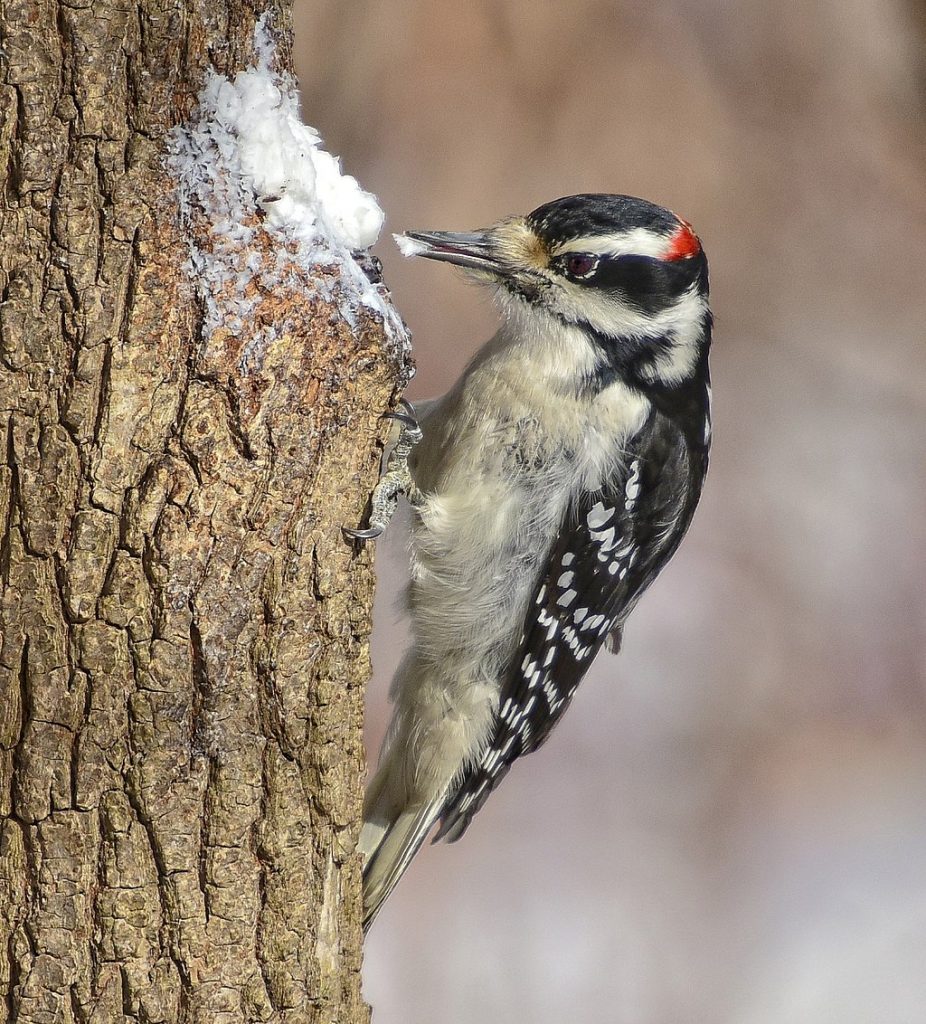
Determining the difference between a Hairy Woodpecker and a Downy Woodpecker is part of “Bird Identification 101”, one of the basic skills that anyone who pursues birdwatching as a hobby will learn early in their avian education.
Hairy woodpeckers are far less common, and generally don’t follow mixed winter flocks. A rule of thumb to follow for identification is that the hairy looks like the downy’s tougher big brother or sister. It is up to four inches longer, about the size of a robin, with a more upright stance when clinging to a tree and a much longer and sharper bill than the downy’s. The hairy has all white tail feathers compared to the white spots on the downy’s otherwise black tail. While the Hairy Woodpecker will also visit backyard feeders, it is more often seen scaling larger and higher trees than its smaller cousin.
The calls of the two birds are similar, but as you might expect, the Hairy Woodpecker’s call is sharper and louder. While the drumming of both birds has been clocked at about 25 beats per second, the larger bird’s drumming is loud enough to be heard more easily by human observers.
- Size: 7.1 – 10.2” long / wingspan – 13.0 – 16.1”
- Florida Status: Far less common than Downy Woodpecker
- Birding Hotspot: Six Mile Cyprus Slough Preserve, Lee County
Yellow-bellied Sapsucker (Sphyrapicus varius)
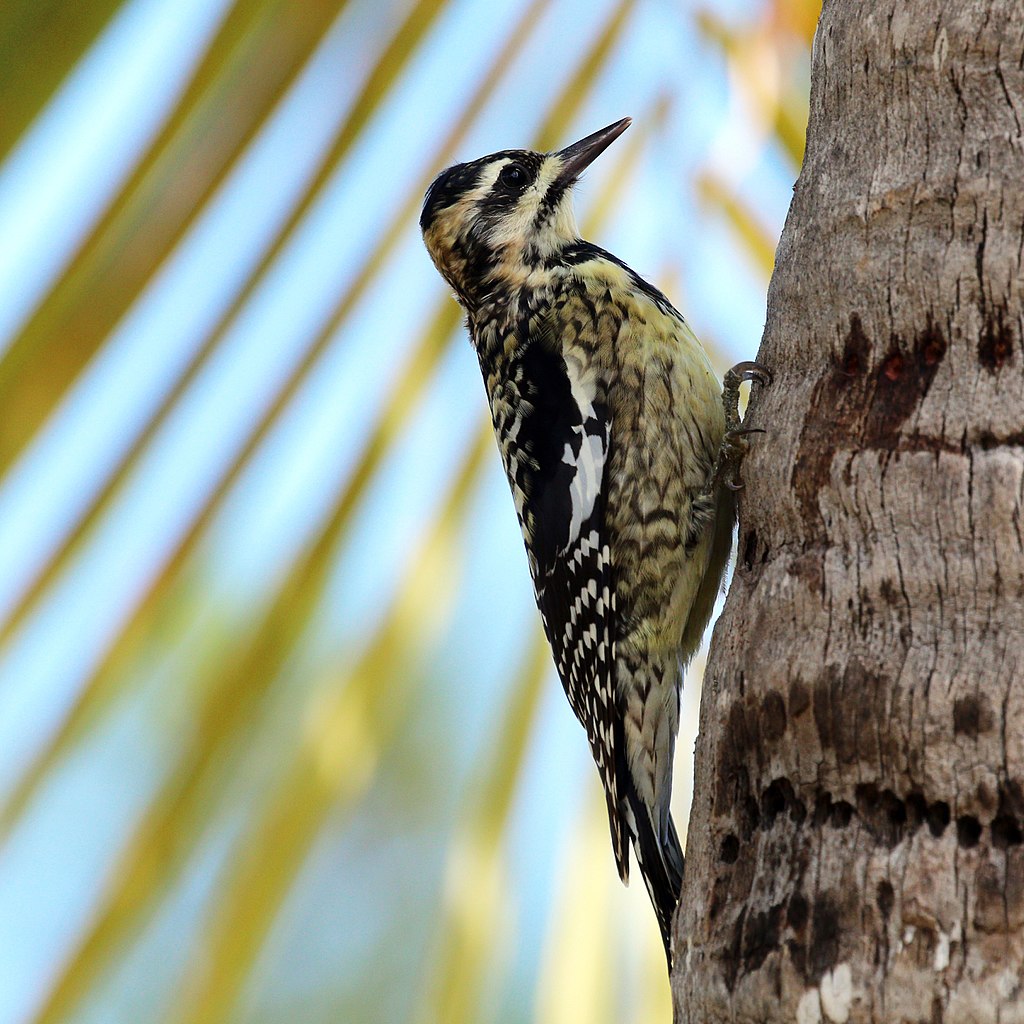
Since Downy Woodpeckers are so common and so tame, they are generally a birdwatcher’s first guess at identification when a black and white bird flies into the backyard with an undulating up and down flight pattern. If the bird has a long beak and seems too big to be a Downy Woodpecker, your second guess would be a Hairy Woodpecker. But if the bird has a deep red crown and throat patch and a band of yellow at the top of its breast, and its winter in Florida, you’ve spotted a male Yellow-bellied Sapsucker.
Sapsuckers are the only North American woodpeckers that are completely migratory. Like many human “snowbirds” in the Northeast, they travel south to spend their winters in the Sunshine State. They get their name from what they do. All woodpeckers excavate nesting cavities in trees to roost and build nests, but most feed by picking away bark and snatching up the insects beneath. The sapsucker uses its long spike of a bill to drill a series of holes in trees to feed primarily on the sap that runs out of those holes, but also on the insects caught in that sap, which the bird scoops up with its’ brush-like tongue.
If you see a horizontal line of holes in the upper trunk of a tree, you can be certain that it’s the work of your local sapsucker. These holes are called “sapwells”, and they also benefit hummingbirds, who will follow the sapsuckers and feed from the tiny excavations. Unfortunately, sapsuckers drill sapwells relentlessly and can often kill a tree in the process of feeding from it.
Like Red-bellied woodpeckers, the distinguishing mark that gives Yellow-bellied sapsuckers their name is a just tinge of color that is barely perceptible. The females have a red crown, but they lack the red throat patch and yellow breast stripe found on the male. Both sexes communicate with a loud “mewing” sound that could be mistaken for a cat in distress. The drumming of the sapsucker is slower and less rhythmic and predictable than other woodpeckers, and they will often drum on metal signs and chimney flashing to amplify the sound.
- Size: 7.1-8.1” long / wingspan – 13.4 – 15.8”
- Florida Status: Common migrant in winter throughout the state
- Birding Hotspot: Fort Zachary Taylor Historic State Park, Monroe County
Red-headed Woodpecker (Melanerpes erythrocephalus)
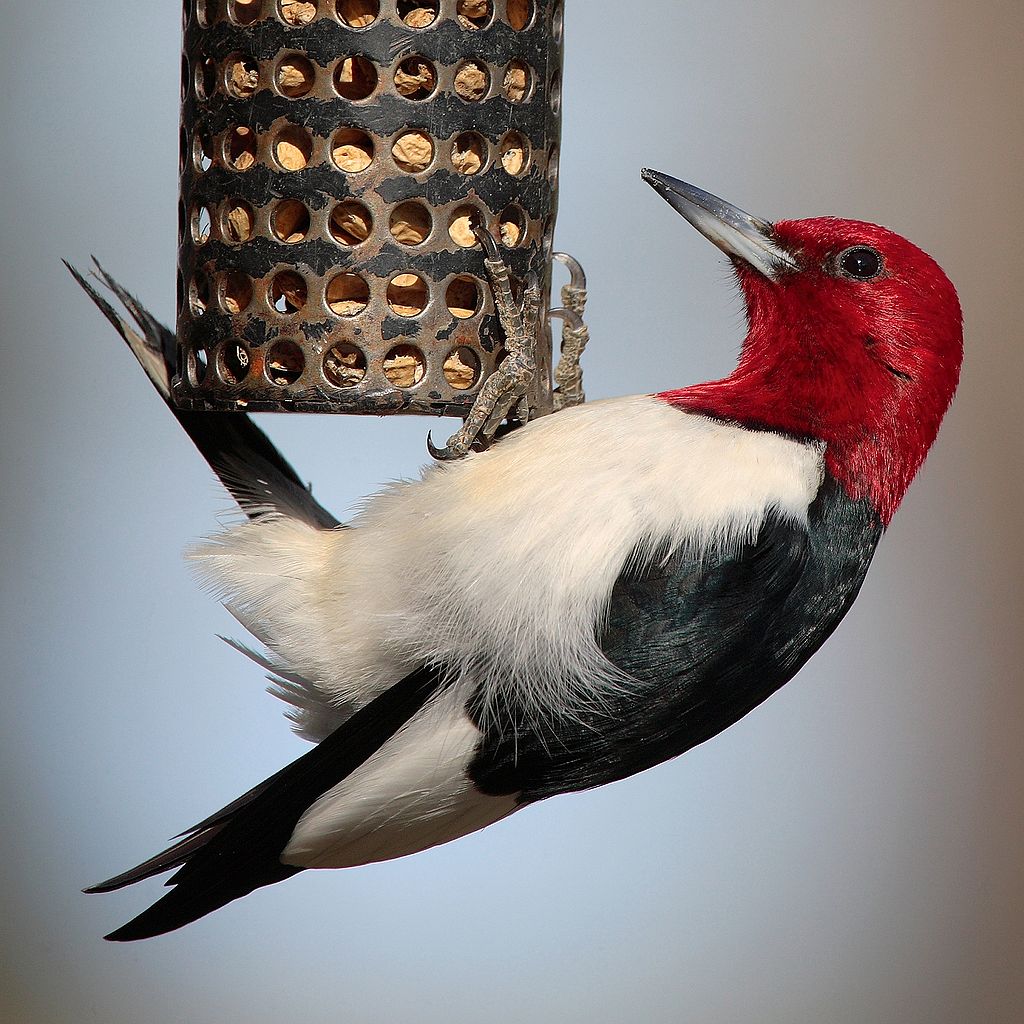
There is no mistaking the Red-headed Woodpecker for any of its Picidae cousins. It is a striking and unique bird with a sleek black and white body and a deep, dark cranberry red head. It is also one of the few woodpeckers with no difference in plumage between the sexes. Its call is similar to the “Churrr!” of the Red-bellied Woodpecker, but shorter and sharper. The drum lasts about 19-25 beats per second in repeated intervals, similar to Downy and Hairy Woodpeckers but significantly louder. Like sapsuckers, it will drum on metal surfaces to amplify the sound. Like flickers, it prefers to nest in trees that abut fields, farms and other open spaces.
“Red-heads” are resourceful birds, noted for storing food under the bark of trees, and sometimes under the shingles of a roof. Although they like the open swamps and wetlands of Florida, their populations have unfortunately been decreasing for years. Part of the reason is thought to be the removal of dead trees, as well as competition for nest cavities with starlings and other birds. Occasionally, these birds are hit by cars as they fly out to catch insects.
- Size: 7.5 – 9.1” long / wingspan – 16.5”
- Florida Status: Uncommon. Found north of Lake Okeechobee
- Birding Hotspot: Escambia River State Wildlife Mgmt. Area, Escambia County
Red-cockaded Woodpecker (Leuconotopicus borealis)
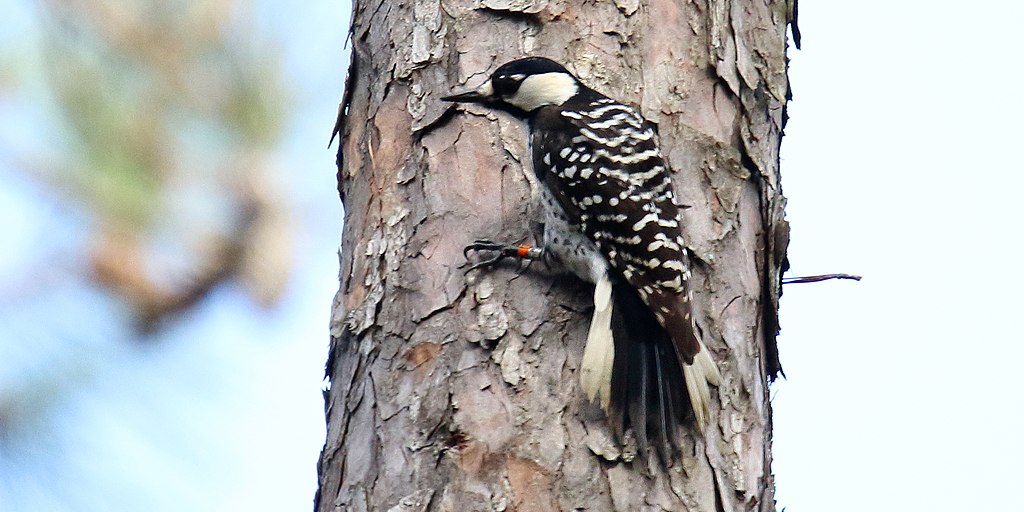
Red-cockaded woodpeckers have been listed as an endangered species since 1970, and Florida is one of the few places where they can still be found. They are similar in appearance to Hairy and Downy Woodpeckers, but with no red markings mixed in with their black and white feathers.
Their name comes from a small red stripe on the head of the male bird known as a “cockade”, an old word for a ribbon or ornament on a hat. They call to each other with a sharp, “Pewww!”, a sound much louder and sharper than that of other small woodpeckers. Their soft drumming, which is actually produced by vibrating their tongue against a tree while feeding on insects, has been compared to an amplified rattlesnake.
Part of the reason for the Red-cockaded Woodpecker’s endangered status is its limited habitat. The birds nest only in stands of pine trees, usually in places where lightning fires have left little underbrush beneath the trees. Stands of longleaf pine were once common in Florida and other southern states, but much of this habitat has been cut for logging and development. For the most part, these birds can now only be found in protected forests and parks around the state.
- Size: 7.9 – 8.1” long / wingspan – 14.2”
- Florida Status: Uncommon, endangered species
- Birding Hotspot: Withlacoochee State Forest, Hernando County
Piliated Woodpecker (Dryocopus pileatus)

If you hear what sounds like the knuckles of God himself knocking on a tree, or you see a large bird in flight that looks like a prehistoric crow with long, outstretched fingers, you’ve caught up with Florida most impressive woodpecker.
The Piliated Woodpecker has a power-packed bill the size of its prodigious head. Both the male and female are mostly black birds with white undersides on their wings and a black and white pattern on their heads. Both have a bright red “pompadour” of a crown, but the male is distinguished by a red moustache. Their call is a clamorous, repetitive “Wuk!Wuk!Wuk!Wuk!”. Their drumming is slightly slower than smaller woodpeckers, but its deep and resonant tone can be heard over mile away in the right conditions.
The holes excavated in dead trees by Pileated Woodpeckers in search of ants and other insects are uniquely rectangular in shape, sometimes drilled so deeply that the tree breaks in half. The cavities created by these big birds are often used as a feeding source for smaller birds who trail behind them. Despite their wild appearance, Piliated Woodpeckers will also occasionally visit backyard suet feeders. And, yes, in case you may have been wondering, their appearance and their maniacal call was in fact the inspiration for the cartoon Woody Woodpecker.
- Size: 15.8 – 19.3” long / wingspan – 26 – 29.5”
- Florida Status: Common in all seasons except for the SE Coast
- Birding Hotspot: Audubon Corkscrew Swamp Sanctuary, Collier County
Final Thoughts
A hundred years ago, you might have had the opportunity to see a woodpecker even bigger than the Piliated, and there are some intrepid naturalists out there who believe that you still could. The Ivory-billed Woodpecker once roamed the upland pine forests and flooded cypress swamps of the south. It was considered rare by the turn of the 20th Century and declared extinct in 1944. But over the subsequent decades, reports of people either seeing or hearing the bird have prompted ornithologists to keep searching for it deep in the wild areas of Florida and Louisiana.
Between 1967 and 1969, two Floridians reported a series of encounters with what they believed were a pair of Ivory-billed Woodpeckers in Highlands County. After a storm damaged the tree where the birds were alleged to have been roosting, a feather believed to belong to one of the birds was retrieved and is now in the Florida Museum of Natural History. The feather could not be dated, so it was not sufficient proof that the birds were there.
So the bad news is that your chances of an Ivory-billed Woodpecker encounter in Florida are not great. But the good news is there is still a fascinating variety of woodpeckers to observe in the Sunshine State, and some great places to see them, from forests and swamplands to the feeders outside your kitchen window.
